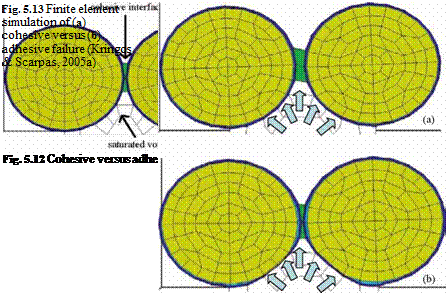Micro Scale Simulation of Combined Mechanical-Water Induced Damage
The motivation for the following micro-scale finite element simulation, is the ongoing discussion about cohesive versus adhesive failure mechanisms in asphaltic mixtures. It is the authors’ belief that, depending on the ability of the individual components and the bond between them, either one of these failure mechanisms may be dominant. It is, therefore, of paramount importance to establish the fundamental relations between environmental weathering and material strength and stiffness. These relations can be used to assist the designer to optimize the water damage resistance characteristics of the mixture at purchase time on the basis of the response of the individual components.
In Fig. 5.12 details are shown of a micro-mechanical mesh that has been utilized for simulation of the results of pumping action due to traffic loading in a porous mixture (Kringos & Scarpas, 2005a).
Depending on the specified characteristics of the individual mixture components, cohesive Fig. 5.13(a) or adhesive Fig. 5.13(b) failure can occur.
 |
Using the same approach, it is possible to study the combined effect of water – induced damage and traffic loading. Because the time-scale of water-induced damage accumulation compared to the time-scale of the mechanically-induced damage differs by several orders of magnitude, mechanical damage can be combined with water-induced damage, at discrete time-intervals. In terms of the finite element simulation, this implies that diffusion studies can be performed until a desired level of water content is attained and the associated water-induced damage in the specimen can be computed. Subsequently, mechanical loading is imposed on the specimen at discrete time intervals and the total damage at a particular time interval can be computed. As can be seen from Fig. 5.14, for the chosen set of material parameters, stripping of the mastic film from the aggregate can be simulated.






Leave a reply